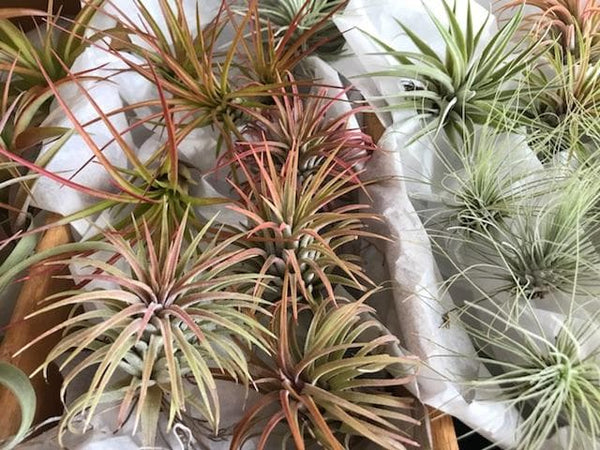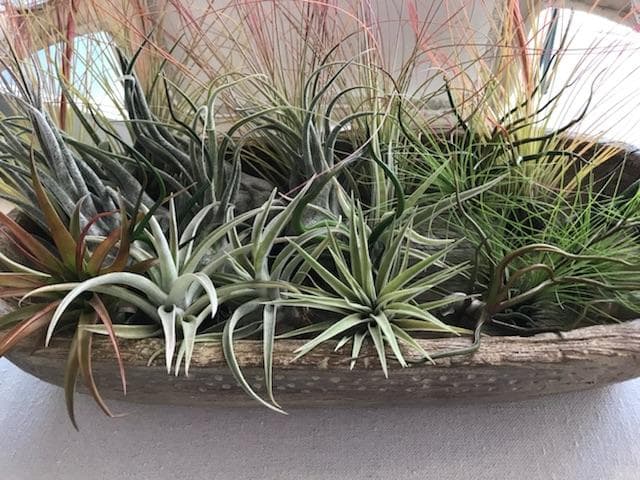Unique and interesting, Tillandsia, also known as air plants, are becoming popular as indoor plants. Learn more about them here.
What Are Tillandsia?
Tillandsia (Tillandsia spp.), more popularly known as air plants, are gaining a reputation as a stylish indoor plant that is effortless to grow and almost “un-killable.”
Interestingly, Tillandsia comes from the pineapple family of Bromeliaceae and are closely related to orchids. They are more or less 500 species plus countless hybrids of these tropical plants scattered around the world.
Air plants native to countries close to the equator, such as those in Central and South America, where there are high levels of humidity and chances of rain to hydrate them naturally. They can be typically seen growing wildly in tropical rainforests, mountains, and deserts of Mexico, United States, and Argentina.
Air plants are epiphytes and attach their roots to any solid matter, which can either be a rock, a tree trunk, or another plant. However, this doesn’t mean that they are parasites. Moss, ferns, and orchid plants are excellent examples of epiphytic plants.
Air plants do not leech off the nutrients from the plant they hang onto; instead, they get the essential nutrients and moisture from the air through the scales in their leaves called trichomes.
Air Plant Varieties

According to experts, each air plant is unique and no two variety is identical. Most Tillandsia air plants come in various sizes from barely an inch to a whopping 15 feet.
Their leaves are usually in many shades of green, but there are also other colorful air plant varieties with foliage in red, purple, yellow, or pink. Some air plants bloom with lovely flowers and give off a pleasant scent. An article by Better Homes and Gardening suggests that air plants with silver leaves seem to be the most drought-tolerant while greener plants dry out faster.
Below is a list of some of the most and popular air plant varieties:
- Tillandsia Lorentziana
- Tillandsia tricolor
- Tillandsia ‘Houston’
- Tillandsia Abdita
- Tillandsia Myosura
- Tillandsia caliginosa
- Tillandsia Huamelula
- Tillandsia Neglecta
- Tillandsia bergeri
- Tillandsia setacea
- Tillandsia Minasgeraisensis
- Tillandsia Igneciae
- Tillandsia Secunda
Tillandsia can be easily propagated by replanting their offshoots, which are more often called as pups.
Air Plants as House Plants

Image: Kew Science
Air plants are a lifesaver for aspiring plant parents who have limited space and a crazy hectic schedule. They are fairly resilient and truly forgiving houseplants that last for years with a decent amount of care. They don’t fall short on looks, too. Like succulents, their exotic and colorful appearance will make it hard for you to stop yourself from collecting and hoarding different types of air plants you can get your hands on.
As their nickname suggests, these air plants don’t need soil or even pots in order to grow. Because of this, you can experiment and play with so many creative ideas when displaying them at home.
Here are some brilliant ways to showcase your air plants:
- Hang your air plants in elegant glass terrariums
- Incorporate them in a succulent arrangement
- Perch them on top of vases with metal stands like miniature trees
- Put them on top of hollow cork-shaped pieces of wood
- Place them inside shallow wine glasses or Ball jars
- Attach your air plants onto a driftwood
- Lay down your air plant on a beautiful piece of ceramic
As you can imagine, the possibilities are endless. Nevertheless, it’s still worth mentioning that a wide and open container is the best option when it comes to a home for air plants because they allow good air circulation and prevents rot or bacteria from stagnant water.
If you do, however, decide to display your air plants in a terrarium or a bottle, make sure to air dry after watering and put it in a bright spot to ensure there’s not a trickle of water that could sit still in the container.
Benefits of Air Plants for You

The awesome benefits of having indoor plants at home and in the workplace are continuously being discovered by more and more people lately.
Air plants, for one, is also blessed in that department. Check out what they can do for you.
- Their mere presence makes any space relaxing and stress-relieving environment.
- As is true for other types of indoor plants, air plants can filter toxins and harmful chemicals from the air you breathe.
- They can inspire you and boost your productivity level.
- They strip indoor air of dust, pollen, and mites that trigger allergies and asthma.
- Air plants make you calmer by reducing unpleasant feelings, such as anxiety, anger, and depression.
- Air plants can ward off disease-causing materials floating in the air by increasing indoor humidity.
Plus, air plants are pet-friendly, too! They are perhaps the only pet-safe option on NASA’s list of air-cleaning indoor plants.
How to Take Care of Air Plants
Follow these practical plant care tips for happy, blooming air plants at home.
- Give your air plants a good soak once a week. Submerge them completely in a basin filled with water for a couple of hours.
- After soaking, make sure they dry out completely before you put them back in their terrariums or wherever you’re usually keeping them.
- As all indoor plants do, air plants will thrive beautifully when given bright indirect light. A south-facing window that catches a bit of morning sun will be an ideal spot.
- For vibrant air plants that reward you with blooms, fertilize once a month. A balanced bromeliad plant fertilizer diluted in water is advisable. Be careful when feeding your air plants. Overdoing it can burn the roots and kill your air plant in a snap.


Leave a comment